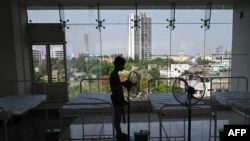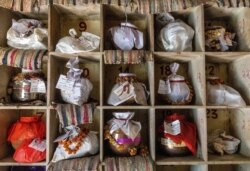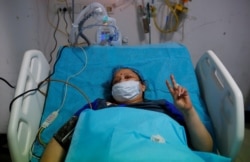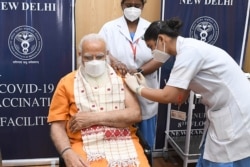Priyanka Jhala lives in Pittsburgh, Pennsylvania, with her husband, daughter, son, and two dogs. She moved to the United States from India in 2013, but her mother, siblings, cousins, aunts and uncles still live in Kolkata and New Delhi.
Like so many of the more than 4 million people of Indian ancestry who now make the United States home, Jhala is watching the coronavirus ravage her native country with horror, helplessness and anger.
“My friends in India tell me walking out of your house feels like walking into a death trap,” she told VOA. “A family member told me you don’t know if the person you’re talking to on the phone today will be OK tomorrow. Everyone sounds so down, defeated and scared.”
Jhala said she’s haunted by accounts of parking lots and parks turned into makeshift crematoriums, and people cutting down trees for wood to burn dead bodies.
Her brother, cousin and in-laws all got COVID-19 but were fortunate to recover without needing a hospital bed.
“But, of course, there wouldn't have been hospital beds if they needed them,” she said. “So what then?”
India is the new center of the COVID-19 pandemic. On Friday, the country reported more than 414,000 new cases — a global record for the number of infections in a single country in one day. The country’s daily death toll also spiked to more than 3,900 on Wednesday and Thursday, up from just more than 600 a month earlier, according to Johns Hopkins University Coronavirus Resource Center.
“It’s terrifying,” Jhala said. “I talk to my family every day, and it feels like there’s nothing I can do.”
Survivor’s guilt
It’s been an unprecedented and terrifying month for Indians. In late January, Prime Minister Narendra Modi boasted to a virtual gathering of global leaders that his country had “saved humanity from a big disaster by containing corona effectively.”
In late March and all of April, however, cases skyrocketed to unprecedented levels. A significant proportion of the more than 21.4 million COVID cases recorded in India have come during the past month. Spiking death rates soon followed.
“All of my loved ones are in India,” said Ketaki Mukhopadhyay, who moved to New Orleans, Louisiana, last year to attend medical school. “They’re there and I’m here, and I’ve got a lot of survivor’s guilt about it right now.”
Mukhopadhyay said many of her friends have lost parents and grandparents to the virus, and she’s worried she may, too, if things don’t get better soon.
“Anything out of the ordinary in my daily FaceTime conversation with them — anyone looking even slightly under the weather — is enough to make me jittery for the rest of the day,” Mukhopadhyay said. “When filial anxiety meets immigration angst, the trauma of not being with my family, physically, is compounded by a lot.”
Braden Lay-Michaels, chief development officer at the American India Foundation in New York City said a sense of guilt is not uncommon among Indian Americans, especially as the United States appears to be emerging from the worst of the pandemic.
“Here, in the U.S., there is the beginning of joy. Vaccines are plentiful, and children are returning back to school,” he said. “But there — where so many of our family and friends are — there aren’t even oxygen canisters to treat the sick, let alone vaccines. You’re watching your home beg for help and it’s devastating.”
Failed preparation
“It breaks my heart,” said Nidhi Srinivas, who moved to New York City with his parents when he was 2 years old. He’s now a college professor there at The New School, though his parents have long since moved back to India.
“I’ve found it hard to sleep, and at times I wake up filled with sadness and terror,” he said, “because it doesn’t have to be this way.”
Srinivas said he’s frustrated at the Prime Minister Modi’s government because India’s public health system has capably deployed vaccinations in the past, eradicating smallpox in the 1970s. And even though the country made it through the first wave of the coronavirus pandemic without spiraling into catastrophe, he said India’s national government should have taken clues from the United States and other countries that a more devastating subsequent wave of infections was possible.
“We had advance warning and time to prepare for a second wave, though we never did,” Srinivas said. “We could have invested in oxygen and still enforced social-distance regulations, but we didn’t do that, either.”
Shrinaath Chidambaram, director of the Association for India’s Development, based in Maryland, believes India’s tragedy stems from a confluence of factors.
“The foundational reason is the long-term underinvestment in the country’s health care system,” he explained, “but other factors include complacency from a relatively lower impact first wave of the virus, a lack of testing and an underreporting of cases, which slowed the reaction to the spike, a lack of forethought in allowing super-spreader events like the Hindu Kumbh Mela festival and state elections without proper precautions, and a lack of transparency in how the government was attempting to prepare for such a spike.”
Responding to a crisis far away
Though she was brought to the United States when she was young, New Orleans resident Tania Zachari’s extended family is in India.
Her mother has been calling relatives in India throughout the crisis and viewing 24-hour coverage of the news, but Zachari said she can’t bring herself to watch the tragedy unfold. One of her cousins contracted the virus and died, and she can sense that not being in India to help the family is taking an emotional toll on her mother.
“I think the worst part is how it seems like there’s no way to control this,” she said. “It’s like what we saw in Italy in March 2020, but the sheer population size and density in India is terrifying to think about.”
Still, Zachari and others said they encourage family members back home to wear masks, stay socially distant — which is difficult in the country’s densest cities — and get the vaccine as soon as possible.
Deepak Raj, chairman of Pratham USA, a nongovernmental education organization in India with chapters in the U.S., sees Indian Americans taking an active role in helping their ancestral country.
“Indian Americans donate roughly $1 billion to charity each year,” he said, “and we volunteer at nearly double the national average in America. There is enormous giving potential, and we’re seeing the community rallying around this cause. Among other things, people are organizing to raise money, send supplies and advocate with their legislators.”
Raj noted that rural and other poorer Indians are struggling even more than is being reported. A black market for oxygen canisters, for example — often necessary in treating coronavirus patients — has emerged. The price is more than 10 times its normal rate, far exceeding what many Indians can afford.
Raj said this is one area in which monetary donations can help. Organizations like Noora Health, the American India Foundation and the Association for India’s Development are collecting and sending funds. Meanwhile, Raj’s Pratham USA is focused on using technology to facilitate education in India, where many students lack internet access and haven’t been in school for more than a year.
Above all, until enough of the country is vaccinated, Indian Americans like Mehdi Khan of New York just hope their faraway relatives can stay safe and healthy.
“To see and hear the people I grew up with, and was raised with, suffering,” he said, “I’m worried, I’m angry and I’m sad. All I can do is donate and advise my family and friends on how we got through the worst of the pandemic when it was here in America.”











